HKSH Mobile App | Wechat Booking
Request an Appointment | Online Booking
Chronic Pain and Work Rehabilitation
Bio-psychosocial Model
Chronic Pain Vicious Cycle
Biological: pain, muscle spasm, joint stiffness, muscle weakness, decrease social activities
Psycho-social: Anxiety, Stress, Depression, Fear Avoidance, Poor sleep

Multidisciplinary Team Approach
Ergonomic Advice:
Sitting

Typing

Position of the screen

Breaks
References:
A handbook for workplaces: Officewise-A guide to health and safety in the office
Office environment & worker safety & health, Centers for Disease Control and Prevention
Chronic Pain Vicious Cycle
Biological: pain, muscle spasm, joint stiffness, muscle weakness, decrease social activities
Psycho-social: Anxiety, Stress, Depression, Fear Avoidance, Poor sleep

Multidisciplinary Team Approach
- Physiotherapy
- Rehab doctor
- Rheumatology specialist
- Anesthesiologist with special training in Pain
- Clinical Psychologist
Ergonomic Advice:
Sitting

- Sit with your hips as far back as they can go in the chair.
- Adjust the seat height so your feet are flat on the floor and your knees nearly equal to your hips level.
- Adjust the back of the chair to a 100°-110° reclined angle with your upper and lower back well supported by the back of the chair.
- Adjust the armrests (if fitted) so that your elbows are well supported and shoulders are relaxed.
Typing

- Make sure the keyboard is close enough to you.
- Place the keyboard directly in front of your body.
- Adjust the keyboard height so that your shoulders are relaxed, your elbows are in a slightly open position (90° to 100°), and your wrists and hands are straight.
- An articulating keyboard tray can be a good option for placing the input devices at the arm rest level. But it should not push you too far away from reaching other material from the desk.
- The tilt of your keyboard is dependent upon the reclined angle of the seat. If you are sitting reclined, a slight increase in the tilting of the keyboard is better. It make sure your wrist is in a neutral position when typing. Wristrest is a good device to maintain neutral posture of the wrist.
- Place the mouse, mouths pad or pointer as close as possible to the keyboard.
Position of the screen

- Place the screen directly in front of you, above your keyboard.
- Position the top of the screen approximately 2-3” above seated eye level.
- Sit at least an arm's length away from the screen.
- Reduce glare by careful positioning and adjusting the vertical screen angle of the screen.
- Either placing the source documents directly in front of you, between the screen and the keyboard or fix it on a document holder positioned adjacent to the screen.
- Place your telephone within easy reach.
- Use headsets and speaker phone to eliminate cradling the handset.
Breaks
- Take short 1-2 minute stretch breaks every 20-30 minutes. Take a 5-10 min break after each hour of work.
- Resting and refocusing your eyes periodically to avoid fatigue. You can also look away from the monitor and focus on something in the distance periodically..
References:
A handbook for workplaces: Officewise-A guide to health and safety in the office
Office environment & worker safety & health, Centers for Disease Control and Prevention
FRAUD ALERT: Reports have been received from the public about fraudulent calls impersonating Hong Kong Sanatorium & Hospital, falsely claiming uncollected medical documents. Do not respond or share personal information. Please be aware of bogus communications (fraudulent websites, emails and phone calls) purportedly from HKSH Medical Group or its members including Hong Kong Sanatorium & Hospital, HKSH Healthcare, HKSH Eastern Medical Centre, HKSH Cancer Centre and affiliates. Do not disclose any personal information to suspicious calls. Please call HKSH Medical Group at 2572 0211 if you have any concerns.





